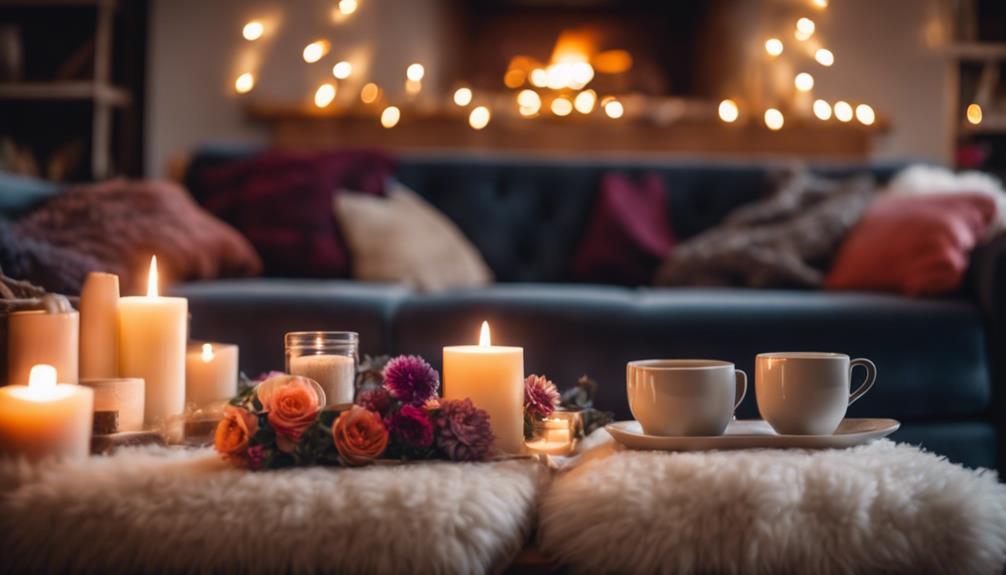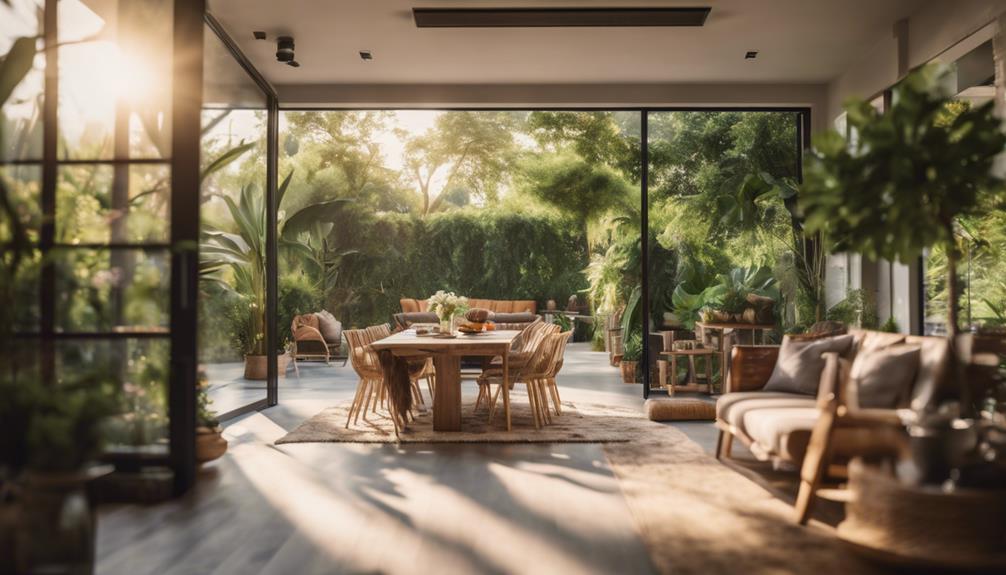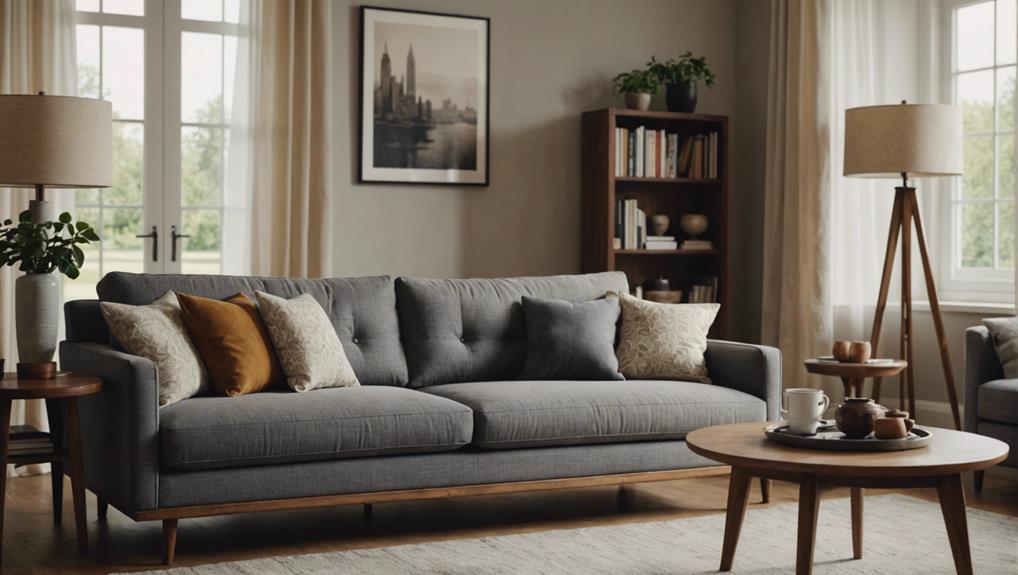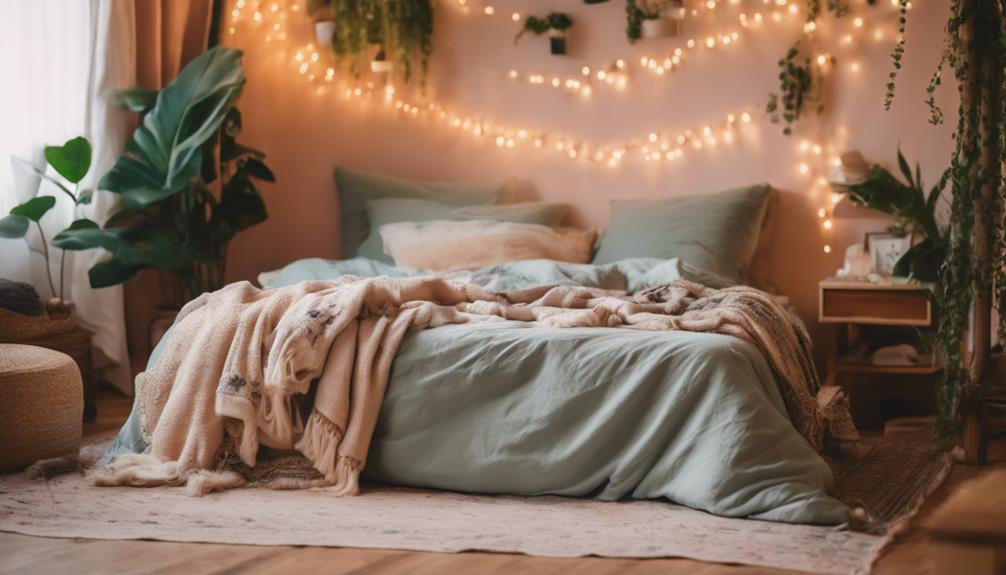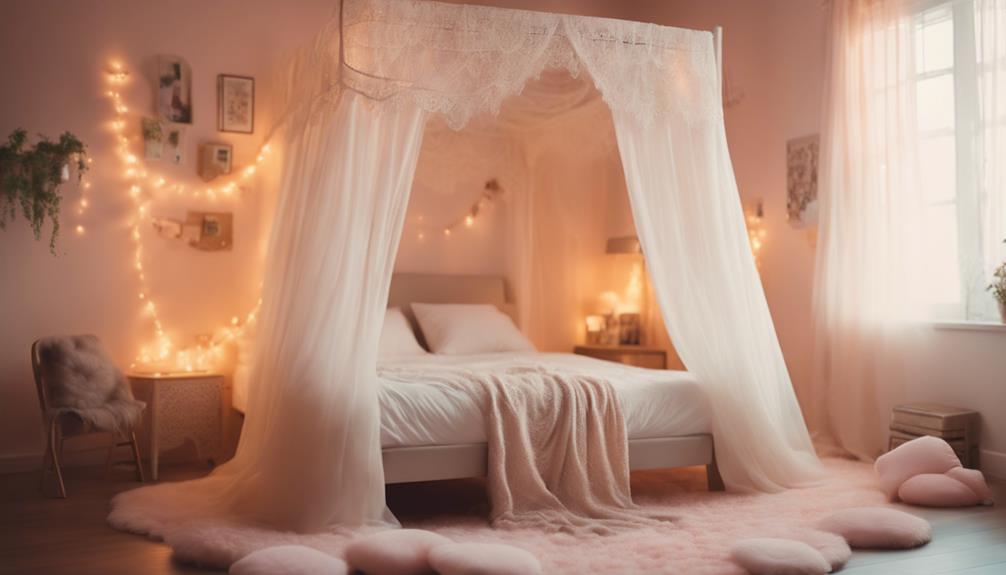To create a cozy living room that keeps your guests lingering, start by selecting warm color tones and soft accents. Layer textiles like plush throw pillows and chunky knit blankets to enhance comfort. Incorporate greenery with houseplants for a revitalizing vibe. Arrange furniture to promote conversation and guarantee pathways remain clear. Personalize the space with unique decor and photos that tell your story. Keep the area tidy and clutter-free, making it welcoming. Finally, don't forget pleasant aromas from candles or essential oils to enrich the atmosphere. There's plenty more to discover that can make your space truly inviting!
Key Takeaways
- Use warm color schemes and bold accent colors to create a vibrant, inviting atmosphere that encourages conversation and relaxation.
- Incorporate comfortable textiles like chunky blankets and plush pillows to enhance coziness and warmth in your living room.
- Arrange furniture to facilitate smooth navigation and encourage engagement, ensuring pathways remain clear for easy movement.
- Add greenery and natural elements, such as houseplants and fresh flowers, to bring life and freshness to the space.
Enhance Entryway Appeal
To truly welcome guests into your home, you should spruce up your entryway with thoughtful details that create an inviting atmosphere.
Start with your front door; it's the first thing your guests see. Make certain it's clean and well-maintained, as a polished entrance sets a positive tone.
Consider adding a bright and cheerful welcome mat. This simple touch can instantly add warmth and personality to your entryway. Cute signs, seasonal wreaths, or welcome banners can enhance the charm and make your space feel more inviting.
Don't forget to introduce some greenery! Potted flowers or leafy plants can liven up the area and draw guests in. They bring a sense of freshness that's hard to resist.
Lastly, verify your entryway is well-lit and free of clutter. A well-lit space not only makes navigation easier but also makes your guests feel welcome and safe.
Explore Color and Design
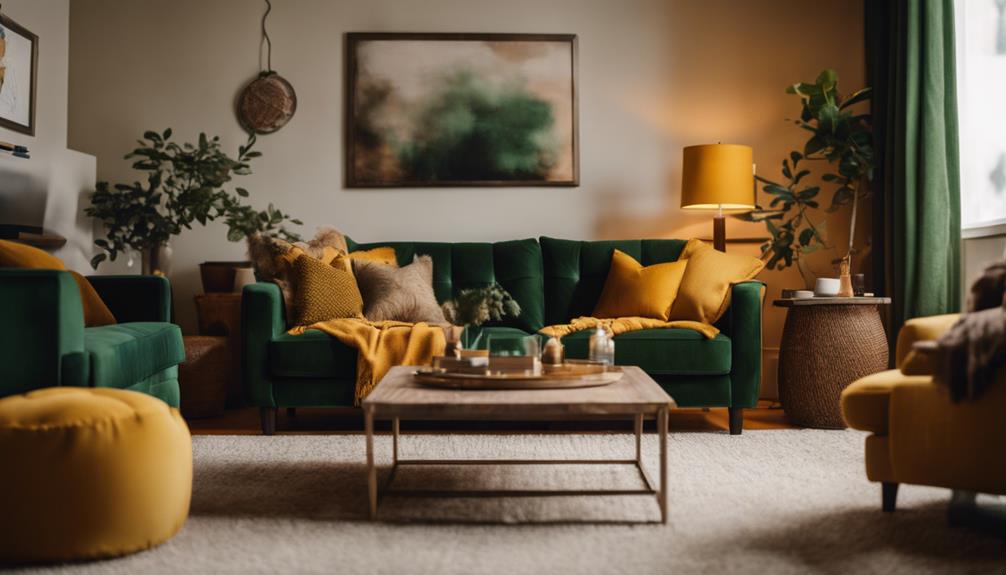
When you explore color and design in your living room, bold accent colors can really make your space pop.
Thoughtful design elements, like layering textures and creating warm color schemes, can transform your room into a cozy haven.
Bold Accent Colors
Bold accent colors instantly transform your living room, creating striking focal points that draw attention to your favorite features. Whether it's a vibrant piece of artwork or a bold sofa, these colors add visual interest and energy.
Incorporating warm tones like red or orange can stimulate lively conversation, while cooler hues like blue or green promote a sense of calm and relaxation.
You can easily update your space by using bold accent colors through accessories like throw pillows, rugs, or wall art. This approach allows you to refresh the room's aesthetic without committing to a full redesign. Plus, vibrant hues enhance the sense of comfort, making your guests feel more at home and encouraging longer visits.
To maintain a cozy atmosphere, pair bold accent colors with neutral tones. This balance prevents overwhelming the space, keeping it inviting and warm.
Thoughtful Design Elements
Thoughtful design elements in your living room can seamlessly blend color and functionality, creating an inviting space that encourages connections and comfort. By carefully considering how colors and decor interact, you can foster a cozy living environment that resonates with warmth.
Here are a few ways to implement thoughtful design elements:
- Bold accent colors: Use these strategically to highlight focal points, enhancing visual interest and making the room feel dynamic.
- Art and unique lighting fixtures: Incorporate these to elevate your design, making the space feel more welcoming and prompting your guests to explore your decor.
Eye-catching elements like colorful decor or unique furniture can create lasting impressions while ensuring easy navigation throughout the space. When your living room flows well, it invites guests to linger, making their experience more memorable.
Warm Color Schemes
Embracing warm color schemes in your living room instantly creates an inviting atmosphere that encourages relaxation and social interaction. Think soft reds, deep oranges, and rich browns to foster a cozy environment. When you incorporate these warm tones through wall paint, furnishings, and decor, you'll notice how the space feels more welcoming, making it easier for guests to feel at home.
To achieve a balanced aesthetic, layer warm colors with neutral shades. This approach enhances the overall look while maintaining that inviting vibe. Don't forget to add accent pieces like throw pillows, blankets, and artwork in warm colors, which can draw attention to focal points within the room and add depth.
Additionally, consider your lighting. Using warm lighting, such as yellow or amber bulbs, amplifies the cozy feel of your warm color schemes. This combination of colors and lighting creates an intimate atmosphere, perfect for gatherings.
Ensure Easy Furniture Navigation
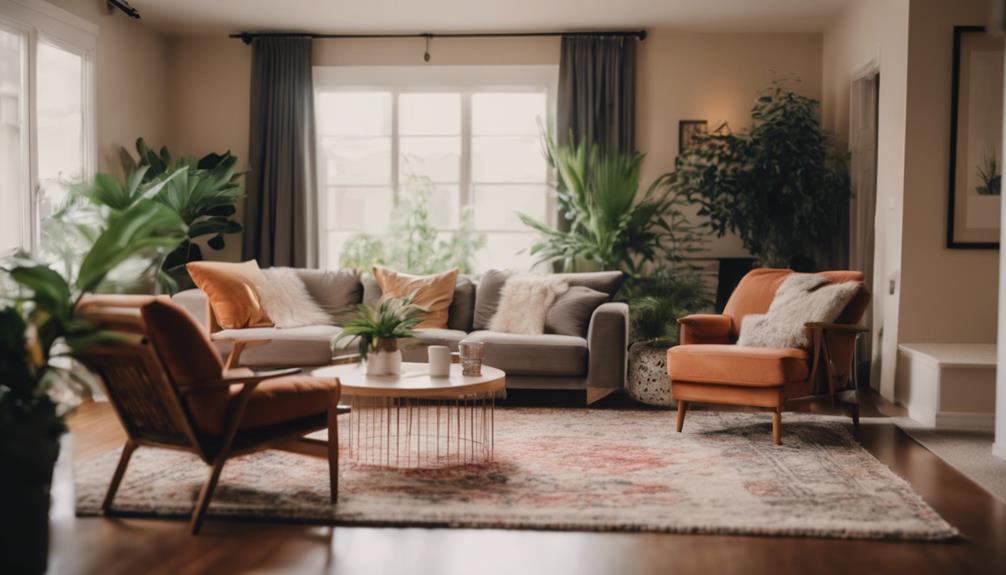
To guarantee easy furniture navigation in your living room, keep pathways between furniture pieces at least 24 inches wide for smooth movement and access. This not only enhances comfort but also makes the room feel more spacious and inviting.
Avoid overcrowding with oversized furniture, as it can lead to a cramped atmosphere and hinder guest mobility.
Arrange your seating to encourage conversation while ensuring all chairs and couches are easily accessible. Here are some tips to enhance navigability:
- Regularly assess floor clutter: Even small items can create tripping hazards and disrupt the flow of movement.
- Use multi-functional furniture: Ottomans or benches provide extra seating and can help maintain clear pathways when not in use.
Embrace Abundant Greenery
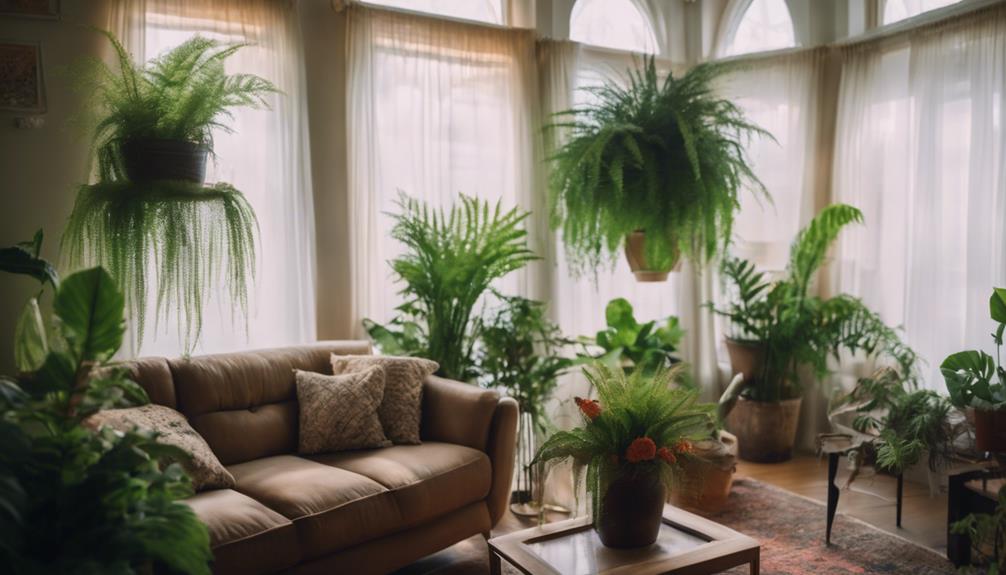
Incorporating abundant greenery into your living room instantly breathes life into the space while enhancing your mood and the air quality. By adding a variety of plants, like trailing vines and vibrant houseplants, you create a lively atmosphere that feels welcoming. Fresh flowers can also serve as focal points, enhancing visual interest and adding a touch of elegance and warmth to your decor.
Positioning your plants near natural light sources helps them thrive, maximizing their growth potential and contributing to a rejuvenating ambiance. This connection to nature fosters a sense of continuity throughout your home, making your space feel cohesive and inviting.
If you're concerned about maintenance, don't worry! Opting for low-maintenance artificial plants can provide a similar aesthetic benefit without the upkeep. They can complement your fresh flowers and real plants, ensuring your living room remains vibrant year-round.
Ultimately, embracing abundant greenery is more than just decoration; it's about creating a sanctuary where you and your guests can relax and unwind. With a little effort, your living room can transform into a lush, inviting space that everyone will love.
Layer Soft Textiles
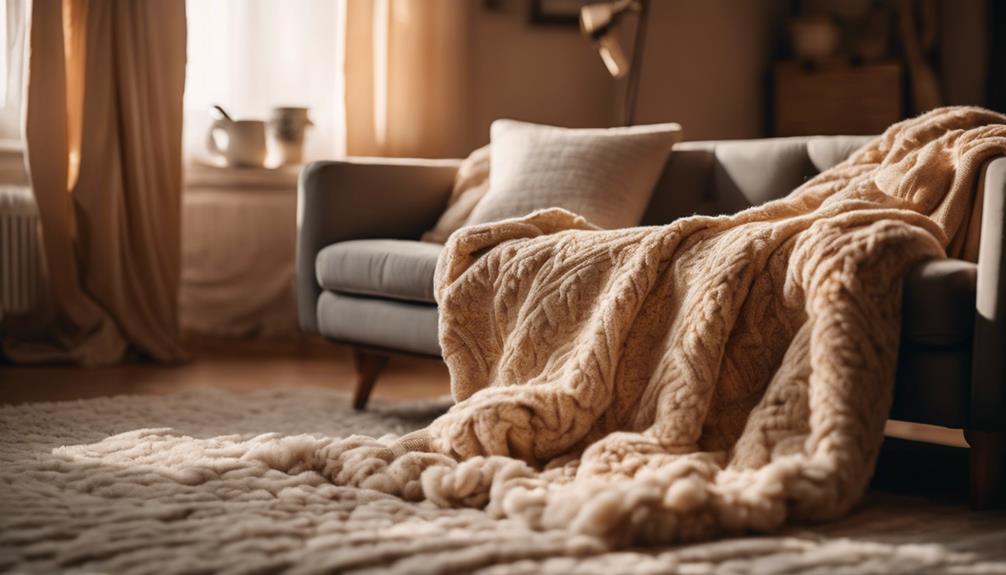
Adding layers of soft textiles can elevate the comfort and warmth of your living room, making it even more inviting after introducing abundant greenery. By incorporating a variety of textures, you can create a cozy atmosphere that encourages relaxation. Think about integrating different soft textiles like chunky knit blankets, plush throw pillows, and sumptuous area rugs.
Here are some ideas to enhance your living room with soft textiles:
- Chunky knit blankets: Drape them over your sofa or armchair for added warmth and texture.
- Velvet and cotton throw pillows: Mix and match colors and patterns for visual interest while providing comfort.
When choosing soft textiles, opt for warm color tones to foster a sense of serenity. Combining various fabrics guarantees that your living room feels personalized and inviting.
With these layers of soft textiles, you'll transform your space into a cozy retreat, making it hard for your guests to leave!
Personalize Your Space
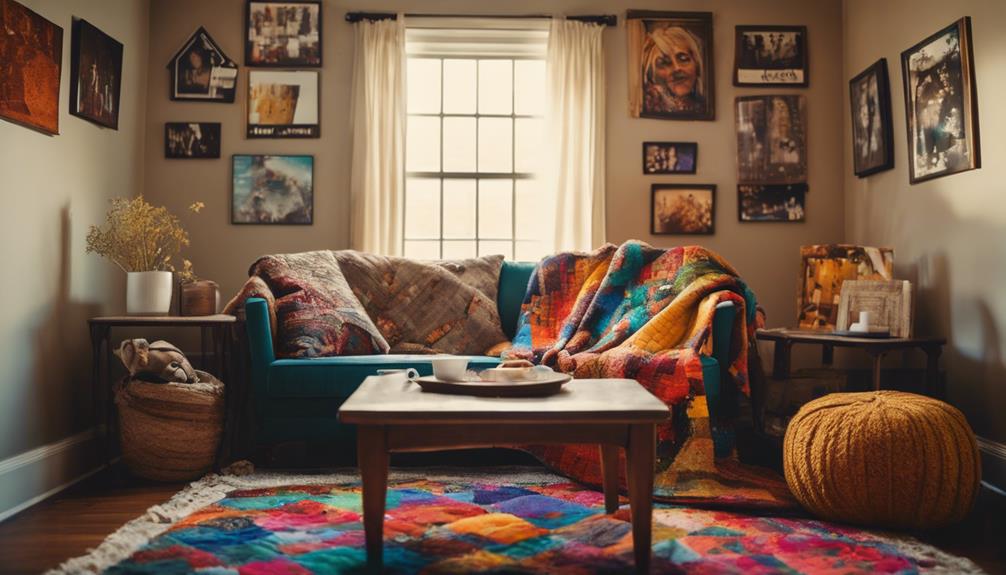
Personalizing your space with distinctive decor and furniture pieces that reflect your unique style instantly makes your living room feel warm and inviting. To truly make your living room yours, consider showcasing items that tell your story.
| Ideas for Personalization | Description |
|---|---|
| Reupholster Standard Furniture | Transform mass-produced pieces with custom fabrics to reflect your taste. |
| Display Personal Artifacts | Use souvenirs and heirlooms to evoke memories and make the room intimate. |
| Incorporate Conversation Starters | Add interesting coffee table books or unique items that spark discussions. |
| Mix Styles | Combine vintage and modern decor for depth and charm. |
Incorporate Unique Details
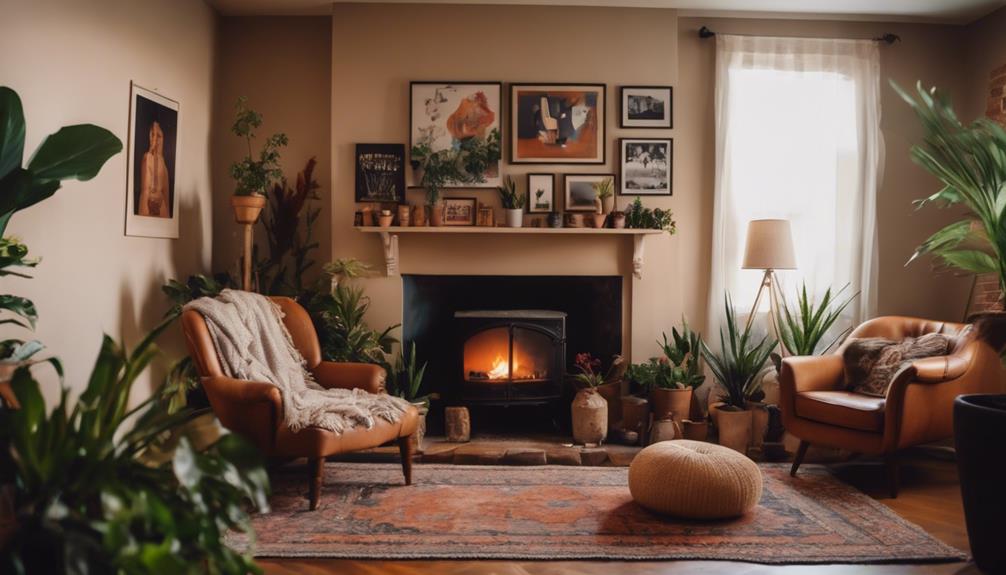
To make your living room truly yours, focus on incorporating unique details that reflect your personality.
Personal artifacts, thoughtful art arrangements, and conversation starter pieces not only enhance the space but also create a warm and inviting atmosphere.
When you add these elements, you'll notice how they transform your room into a cozy haven.
Personalized Decor Elements
Incorporating unique decor pieces like handmade crafts or vintage finds instantly reflects your personal style and sparks conversation in your living room. Personalized decor elements not only make your living room feel special but also create an inviting atmosphere for your guests.
To enhance your space, consider these ideas:
- Display family photos or personal artifacts in stylish frames to evoke memories and add warmth.
- Use reupholstered furniture to transform standard pieces into customized items that showcase your personality.
Curating a collection of coffee table books or decor items that resonate with your hobbies can also help make your living room uniquely yours. When your guests see pieces that tell your story, they'll feel more connected and engaged.
Thoughtful Art Arrangements
Thoughtful art arrangements can breathe new life into your living room, inviting exploration and sparking conversation among your guests. To create an inviting atmosphere, consider incorporating unique details like eclectic frames or unexpected placements. These small touches can add character and personal flair to your wall decor.
Mixing different art styles, such as modern pieces alongside vintage finds, creates visual interest and a dynamic ambiance. This contrast not only showcases your personality but also encourages guests to engage with the art.
Utilizing a gallery wall format allows you to showcase a variety of personal artifacts and memories, making the space feel lived-in and warm. Don't be afraid to experiment with layouts and arrangements—there's no one right way to display art!
Conversation Starter Pieces
Conversation starter pieces add a layer of intrigue to your living room, inviting guests to engage and share stories that reflect your unique style. These elements not only enhance aesthetics but also create a welcoming atmosphere for conversation and connection.
Here are some ideas to incorporate:
- Unique Art: Choose pieces that resonate with you, sparking discussions about their meaning or creation.
- Interesting Coffee Table Books: Display books showcasing your hobbies or travels, encouraging guests to browse and discuss their own experiences.
Additionally, consider using eye-catching decorative trays to group smaller items like candles or coasters, serving as focal points that prompt conversations.
Unique furniture pieces, such as a sculptural chair or a handcrafted side table, can also be conversation starter pieces, drawing attention and admiration while leading to discussions about design and craftsmanship.
Maintain a Clutter-Free Zone
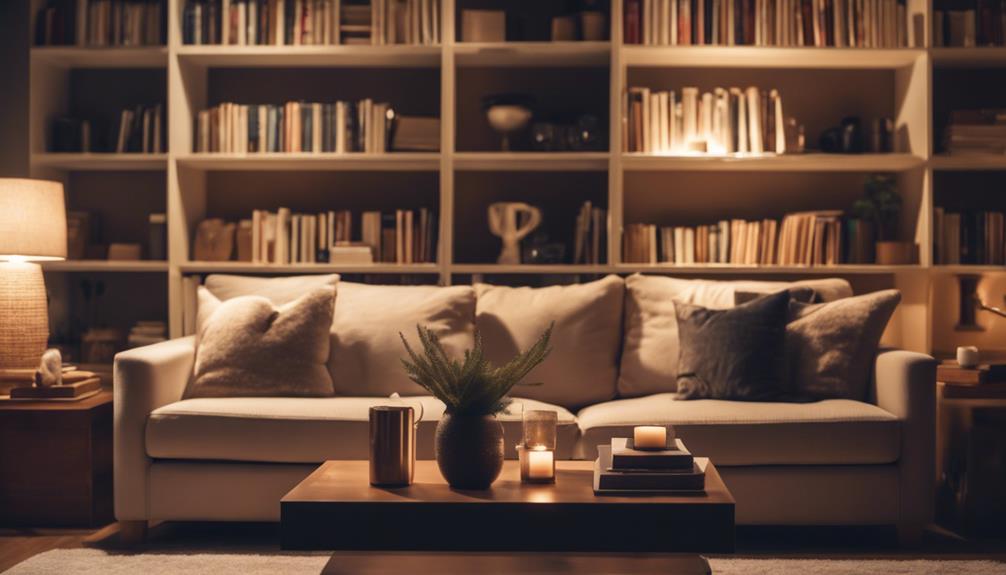
A clutter-free living room not only reduces stress but also creates an inviting space for both you and your guests. To achieve this, start by designating specific storage solutions for everyday items. Use baskets or decorative boxes to keep surfaces clear and organized. This way, you'll always have a designated spot for remote controls, magazines, and other essentials, which helps maintain a clutter-free environment.
Regularly assess and organize stacks of papers and magazines to prevent accumulation. Setting aside a few minutes each day for tidying can make a big difference. Implementing a daily routine guarantees your space remains welcoming, especially when unexpected guests drop by.
Adopting a minimalist approach to decor can also enhance the sense of openness and comfort in your living room. By reducing distractions from clutter, you allow your guests to focus on the warmth of your space.
Create Pleasant Aromas
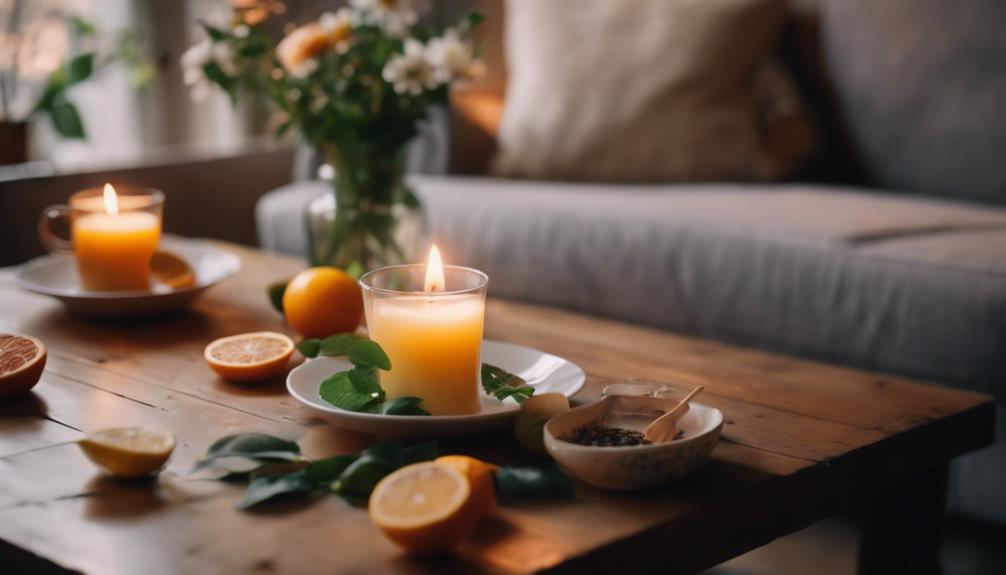
Pleasant aromas instantly transform your living room into a warm and inviting haven for guests. To create an atmosphere that feels cozy and welcoming, focus on introducing delightful scents that uplift the mood. Here are a few ideas to get you started:
- Use candles or essential oil diffusers to fill your space with inviting fragrances.
- Incorporate fresh flowers or herbs for natural beauty and delightful aromas.
Regularly assess and refresh your home's odors. Well-ventilated spaces are essential; ensuring proper air circulation helps maintain pleasant aromas while preventing unpleasant odors from lingering.
Take time to find scents that resonate with you and your guests, as they can evoke warm memories and enhance the overall ambiance.
Frequently Asked Questions
How to Make a Living Room More Inviting?
To make your living room more inviting, incorporate soft textiles, use layered lighting, add plants, personalize decor, and guarantee comfortable seating arrangements. These elements create a warm atmosphere that encourages relaxation and socializing.
How to Make Your Living Room Cosy?
You might think coziness requires a lot of effort, but it doesn't. Just add soft textiles, warm lighting, and some greenery. Personalize with your favorite decor, and you'll instantly transform your living room into a cozy haven.
What Makes a House Look Welcoming?
A welcoming house features a clean entryway, vibrant greenery, and soft textiles. Eye-catching decor and personal touches invite exploration and create warmth, making guests feel at home and enthusiastic to linger a little longer.
How Can I Make My House Cozy for Guests?
To make your house cozy for guests, incorporate soft textiles, use warm lighting, and add greenery. Keep it clutter-free and personalize the space with decor that reflects your style, fostering connection and comfort.
Conclusion
By enhancing your entryway, exploring color, and ensuring easy navigation, you're setting the stage for comfort.
Embracing greenery, layering textiles, and personalizing your space invite warmth.
Incorporating unique details and maintaining a clutter-free zone create harmony, while pleasant aromas wrap it all together.
With these tips, your living room transforms into a cozy haven where guests feel welcome, stay longer, and leave with fond memories.
So go ahead, make your space inviting, and let the good times flow!
